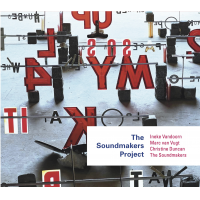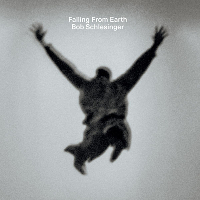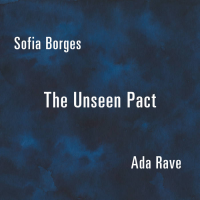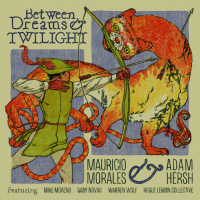Home » Jazz Articles » Multiple Reviews » Between The Lines Turns Five, Part 2-2
Between The Lines Turns Five, Part 2-2
I apologize for the delay between parts 1 and 2 of this trek through an incredibly varied body of recordings. Rather than repeat my introductory remarks (seen here ), I will summarize the basic esthetic of the record label known as Between the Lines. Franz Koglmann wants to explore the boundary edges of the compositional and the improvisational, the intersection of jazz (however you define it) with other performing arts and the juxtaposition of "high" and "low" art.
Besides featuring his own composing and playing (which is always very engrossing), he records those works of a group of like-minded composer/players including Tony Coe, Peter Herbert and James Emery. Part of the point is Koglmann's insistent resistance to labels, which I guess can be a label in itself, but the main thing to remember with these recordings is to not prejudge or precondition yourself and just let the music happen. In this second half of the set, there is much more that I would say crosses over the line into the classical world, but so what. Liking or not liking something can be separated from experiencing it; and one might grow to like something than initially repulsed.
I am also quite aware of buying something and being disappointed. Jazz is becoming a commodity, and the more one becomes familiar with the breadth of jazz, the less one is satisfied with the merely competent. We want to be stunned into silence, have time and space change. Obviously I can't predict your response to any of the recordings below, but I can say that I was never bored, and 'playing the changes' never happened.
 Franz Koglmann
Franz Koglmann
Venus In Transit
btl 016
The short story of the genesis for this music is that Koglmann was asked to write the music for a theater project named 'Vivace'. 'Venus in Transit' is a play within a play, and "interwoven with four other plays - tells the story of a young man who grows breasts after his girlfriend has given him anabolics to increase his muscle power." The writer, Beverly Blankenship, then did an inspiring rendition of "I Wanna Be Loved By You," of Marilyn Monroe fame, and Koglmann decided to base the music on this song (and others connected to Monroe - "Some Like It Hot"). The music is episodic in nature, but can be very funny, along with the group producing many different sounds. Echoes of the Monroe tunes continually surface, and the first track stayed with me for days. There is a second section, entitled "Wahlverwandtschaften" relates to Goethe's work of that name which means "Elective Affinities" (but you knew that, right?). The music is supposed to be a demonstration of Goethe's remark that "architecture was music in a solid form and that the atmosphere that it created was very similar to the effect which music had." We are in the land of hearing architecture and seeing music, which is mind-stretching to say the least!
Personnel: Franz Koglmann (tpt), Chris Speed (ts, cl), Michael Rabinowitz (bassoon), Mat Maneri (vla), David Fiuczynski (g), Peter Herbert (b), John Mettam (cocktail drums, percussion), Wolfram Igor Derntl (vocals)
 Franz Koglmann
Franz Koglmann
Don't Play, Just Be
btl 021
From Koglmann: "In stark contrast to any demonstrative bravado, "Don't Play, Just Be" aims at the maximum of easy-going, confident serenity, especially as regards the improvisations of the soloist quartet." The first section is made up of four pieces for quartet and chamber orchestra that run into each other. "Nuit Blanche" is just flat out beautiful with outstanding playing from Koglmann and Coe. "Don't Play, Just Be" is more excitable, bringing in the drums and a kind of big-band sound. "Rivette" is lighter and contains nods to purely popular culture, while "Blue Look" stays in rhythm a bit more in the beginning, but the ending a-rhythmic section is another beauty. The second section is music (with vocal) to four poems relating to love from different points of view. The words are surprisingly not translated, and the singing is on the recitative side. "Entre chien et loup" brings back the quartet and is dedicated to "Reporters Without Frontiers." More great playing from Koglmann, Coe, Herbert and Emery.
Personnel: Ursula Fiedler (soprano), Tony Coe (cl, ts), Franz Koglmann (flgh), James Emery (g) Uli Fussenegger (b), Peter Herbert (b, track 9) with the Klangforum Wien
 John Lindberg
John Lindberg
Ruminations Upon Ives And Gottschalk
btl 025
Lindberg states that two of his heroes are Gottschalk and Ives, and these pieces represent his admiration through his writing and the quartet's playing for Gottschalk's "global influences" and Ives' "fantastic humor, unbudgable integrity and love of surprising counterpoint and its extrapolation." Lindberg states that "Spirit Great, Golden Shine" was a reaction to 9/11, and a tribute to Gottschalk's "Holy Spirit, Light Devine," and that "Generations" is a "pointed salute to Charles" in an "oddball march." I found the music very funny at times, at others quite moving. Lindberg is a very strong bassist, and leads the quartet with a sure hand, both as a performer and composer. As with the discs in part one, I have no idea how the music was notated to provide for the seamlessness of the composed and the improvised. Once again, as before, you must let this music come to you without saying this is, or isn't jazz, since in the notes Lindberg says that he is a "so-called jazz composer fully considering two so-called classical composers. Can't we all just be composers? Period?" I kept feeling that I was listening to something very profound, and yes, space and time were changed, which is a very, very good sign.
Personnel: John Lindberg Quartet: Lindberg (b), Bakida Carrol (tpt, flgh), Steve Gorn (bansuri flutes, cl, ss), Susie Ibarra (d, perc, kulingtang, Chinese gongs)
 Andreas Willers
Andreas Willers
In The North
btl 026
Andreas Willers states that was to be a "hommage to the legendary composer/improvisor Jimmy Guiffre, and his impressive body of work, it ended up being more than just that." In getting to the point of actually assembling the musicians in the studio, much thought went into what a 'hommage' meant with such a figure. In the end four tunes of Guiffre's were included and the others are originals in the spirit of exploration of Guiffre by various combinations of the participants - the players met for the first time as a quartet in the studio! Overall, the music is achingly, almost hauntingly beautiful, and I don't know if it projection on my part that the title "In The North" seems to perfectly describe the desolate, cold, empty space that the music creates. The 'tune' "In The North" itself almost made me cry, and the rest was quite intense, pulling me this way and that. Willers is an incredibly inventive guitarist, and Bley is a most concentrated pianist who can get a beautiful sound. Robert's trombone get all sorts of sounds, listen to the pitched sucking in "The Train & the River." This disc was literally a trip!
Personnel: Paul Bley (p), Yves Robert (tbn), Andreas Willers (el. 7 ac g) Horst Nonnenmacher (b)
 James Emery
James Emery
Transformations
btl 027
In the notes Emery writes about how he, for the last 20 years, been exploring way to mix improvisation with composition. "Several years ago, I began to think that the optimal performance of my music could be accomplished by having on the one hand all or most of the improvisations played by musicians whose greatest skills are as creative improvisors and on the other hand, to have all or most of the written music played by musicians who are trained to perform the notated wishes of the composer. "Transformations" is the result of this approach. The first eight tracks are the movements for "Transformations - Music for 3 Improvisors and Orchestra." Emery states that he did not want this to be a concerto with the orchestra subservient to the soloists, but taking a equally important role. From this viewpoint the composition is a success, even if the orchestral parts do have a more 'classical' sound, but with the occasional 'jazzy' rhythm popping up. There are three interludes featuring Emery (again blazing impossibly fast) with different mixes of the other soloists. The quartets are quite different, and Peter Herbert's wonderful bass joins in. "Down Home Tone Poem" actually swings and stayed with me for as long time. "Bird's Nest" is an intriguing mid-tempo ballad-like work with many interesting sounds. The two "Full Circles" (parts 1 and 2) are almost what one might think of as advanced 'normal' improvisational jazz. I had a good time with this project from Emery.
Personnel: James Emery (g), Tony Coe (ts, cl), Franz Koglmann (flgh), Peter Herbert (b) (tracks 9-13)
 Yitzhak Yedid
Yitzhak Yedid
Myth Of The Cave
btl 028
Yedid says that the inspiration is Plato's "The allegory of the cave," the essence of which is that those who manage to perceive reality and not the accepted illusion end up being rejected and persecuted by those still blind and lost in delusion. The music itself feels very composed, more here, less there, and is in many styles - twelve tone and extreme romantic for example. Yedid says that he needs three different approaches from the players: (1) extreme committment to playing the notes as written, but, at the same time expected to give commentary,even changing notes if the need is felt, (2) to express emotions through "deliberately guided improvisational structures" and (3) to add a composed part or to totally improvise. He also says that "one has to listen to the entire composition to understand the musical conceptual meaning." So, once again we at the intersection of the composed and the improvised. Let me say up front that the players are first rate, and turn on a dime totally together many times, which means much rehearsal, but also a clear meeting of the minds and souls. The question of whether this is 'jazz' or not is moot, but it does not sound improvised to me, and maybe that is the point. The music vacillates between the simple and the complex, between the direct and oblique, between thick and thin textures. It does demand one's full attention for a full hour, and as before, if you let it wash over you, it will transport you and change space and time - the mark of art in music.
Personnel: François Houle (cl, bass cl), Ora Boasson (b), Yitzhak Yedid (p)
 Oskar Aichinger
Oskar Aichinger
Synapsis
btl 029
Says Aichinger: "The clarity of mind that comes about when brain waves and neuron pathways that were previously shut off from each other suddenly connect, and current flows between them. This is the mood that has become increasingly palpable throughout the production of this CD, culminating in the certainty that things have come together here. Divergent elements - different historical memories, electronics and traditional instruments, the attitudes of the performers - have been amalgamated in a sort of biochemical process." Forgive the long quote, but sometimes the composer says describes his music the best. As you can see, there are two synthesizers, a computer, a regular bass and piano and drums (extended - by what?). If you take the repetitive construct of New Age music, remove the insipid elements, and add some inspired sound/music creation, you have somewhat of an idea of what this sounds like, if you add in sections of industrial head banging and rock drumming, which, just as your head starts nodding changes to music/ sound that evokes endless space (inner or outer). The 45+ minutes are arranged into four sections, which have sub-movements in the 3 to 5 minute range, so if something doesn't tickle your fancy, just wait as bit. I fought the impulse to think of this music as less 'important' than the previous one, but realized that it came from the presence of explicit and simple rhythms sprinkled throughout. Bring some friends over and put this on, then sit back and watch their faces.
Personnel: Oskar Aichinger (p, synthesizer), Stefan Nemeth (synthesizer, computer), Achim Tang (b) Paul Skrepek (extended drums)
 Peter Herbert
Peter Herbert
You're My Thrill
btl 032
We now meet the composer side of Peter Herbert, the master bass man. This project is in two parts, the first being a tribute to Billy Holiday which he has wanted to do for a long time. He has cast Christine Tobin as the chanteuse, having worked in her band. She sounds nothing like Billy, except maybe of the pathos that comes from using Billy's characteristic dropping off of a note, which is OK, because the music uses the familiar melodies as the basis for the compositions, and cannot be thought of as mere artistic "interpretations." Herbert gives us reworked versions of "Solitude," "You're my thrill," "Porgy," "Gloomy Sunday" and "Ain't nobody's business" which hover between jazz (meaning the popular) and art music (i.e. lieder). The effect is quite enchanting and haunting. On the second part, "Communications Error," Herbert says, "[this work] is one of many works, where I reflect musically on different sound snippets, in this case sounds from human beings on the street. Each movement has a different topic, all dealing with some sort of communications error." This music is quite different than the first section, although being in close juxtaposition, I could hear some kind of compositional stylistic link. Personally, the 'sounds of the streets of New York' do not connect me with the music, but the music quite easily carried itself.
Personnel: Christine Tobin (vocals) and a large ensemble
 Franz Koglmann
Franz Koglmann
Fear Death By Water
btl 034
The liner notes start with this quote from Louise Bourgeois: "Happy people have no stories, they have no history, they have nothing to say. They are happy, and that is utterly unproductive." Maybe this strikes you, as it does to me, as sneering at the 'common people'. The work is based on T. S. Eliot's "The Waste Land," "which explores the social situation after the First World War.," and I must say that I found it a bit depressing. In any case, this last work is the closest to totally composed music, in fact a 'Beach' Opera, albeit with improvised sections featuring Tony Coe, Koglmann and Peter Herbert. There is an enclosed libretto in German and English, and it is worth following, since you are not watching a stage production. I don't want to get into all of the allegories and musical representations that float through the hour of music. There is recitative-ish singing, spoken language with a Jazzy background. The introduction is quite eerie with jet-like sounds wizzing by with wispy ghost chords softly wailing behind. There is much beauty, some cool quartet sounds, and, if you can get into the production as a whole, a message. Not for everyone for sure, but neither is Cecil Taylor or even Lester Young.
Personnel: Christian Baier (libretto), Morenike Fadayomi (vcl), Walter Raffeiner (vcl) Birgit Doll (vcl), Alexander Waechter (vcl), Nikolaus Kinsky (vcl), Monoblue Quartet: (as above, but Martin Stewart (g) for Burkhard Stangl, and Wolfgang Reisinger (drums) as guest), with the Ensemble XX Jahrhundert
So, my trip is done, and quite a lot of the most intriguing music was traversed. Never being boring might seem like a backhanded compliment, but in these days of jazz as commodity, any music that comes out of the attitude of "I want to reach you" just cannot be ignored. Give some of them a try, and you most definitely won't bored and will most likely become engrossed. Forget about jazz as a label and let the music wash over you, invest an hour, and it might become a habit.
Tags
PREVIOUS / NEXT
Support All About Jazz
 All About Jazz has been a pillar of jazz since 1995, championing it as an art form and, more importantly, supporting the musicians who make it. Our enduring commitment has made "AAJ" one of the most culturally important websites of its kind, read by hundreds of thousands of fans, musicians and industry figures every month.
All About Jazz has been a pillar of jazz since 1995, championing it as an art form and, more importantly, supporting the musicians who make it. Our enduring commitment has made "AAJ" one of the most culturally important websites of its kind, read by hundreds of thousands of fans, musicians and industry figures every month.























